Obsolete form of removable media

Disk packs and disk cartridges were early forms of removable media for computer data storage, introduced in the 1960s.

Disk packs and disk cartridges were early forms of removable media for computer data storage, introduced in the 1960s.
| Computer memory and computer data storage types |
|---|
| Volatile |
| Non-volatile |

A disk pack is a layered grouping of hard disk platters (circular, rigid discs coated with a magnetic data storage surface). A disk pack is the core component of a hard disk drive. In modern hard disks, the disk pack is permanently sealed inside the drive. In many early hard disks, the disk pack was a removable unit, and would be supplied with a protective canister featuring a lifting handle.
The protective cover consisted of two parts, a plastic shell, with a handle in the center, that enclosed the top and sides of the disks and a separate bottom that completed the sealed package. To remove the disk pack, the drive would be taken off line and allowed to spin down. Its access door could then be opened and an empty shell inserted and twisted to unlock the disk platter from the drive and secure it to the shell. The assembly would then be lifted out and the bottom cover attached. A different disk pack could then be inserted by removing the bottom and placing the disk pack with its shell into the drive. Turning the handle would lock the disk pack in place and free the shell for removal.
The first removable disk pack was invented in 1961 by IBM engineers R. E. Pattison [1] as part of the LCF (Low Cost File) project headed by Jack Harker. The 14-inch (356 mm) diameter disks introduced by IBM became a de facto standard, with many vendors producing disk drives using 14-inch disks in disk packs and cartridges into the 1980s.
Examples of disk drives that employed removable disk packs include the IBM 1311, IBM 2311, and the Digital RP04.

An early disk cartridge was a single hard disk platter encased in a protective plastic shell. When the removable cartridge was inserted into the cartridge drive peripheral device, the read/write heads of the drive could access the magnetic data storage surface of the platter through holes in the shell. The disk cartridge was a direct evolution from the disk pack drive, or the early hard drive. As the storage density improved, even a single platter would provide a useful amount of data storage space, with the benefit being easier to handle than a removable disk pack. An example of a cartridge drive is the IBM 2310, [2] used on the IBM 1130. Disk cartridges were made obsolete by floppy disks.
Disk drives with exchangeable disk packs or disk cartridges generally required the data heads to be aligned to allow packs formatted on one drive to be read and written on another compatible drive. Alignment required a special alignment pack, an oscilloscope, an alignment tool that moved the read/write heads, and patience. The pattern generated on the scope looks like a row of alternating C and E characters on their backs. Head alignment needed to be performed after head replacement, and in any case on a periodic basis as part of the routine maintenance required by the drives.
The alignment pack was usually called the "CE pack," because IBM never called their 'service technicians' 'repairmen,' but "Customer Engineers" (CEs). And, since the alignment pack was only to be used by CEs, it was called the "CE Pack." Special CE media was also available for tape drives and diskette drives, known as "the CE tape" and "the CE floppy."
Later drives with exchangeable packs (such as the CDC 8" Lark drives) embedded the servo with the data and didn't require regular head alignment.[ dubious – discuss ]
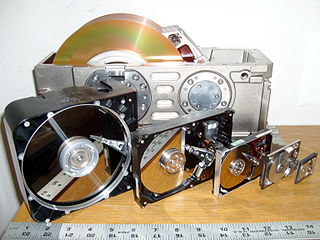
Disk storage is a data storage mechanism based on a rotating disk. The recording employs various electronic, magnetic, optical, or mechanical changes to the disk's surface layer. A disk drive is a device implementing such a storage mechanism. Notable types are hard disk drives (HDD), containing one or more non-removable rigid platters; the floppy disk drive (FDD) and its removable floppy disk; and various optical disc drives (ODD) and associated optical disc media.

A floppy disk or floppy diskette is a type of disk storage composed of a thin and flexible disk of a magnetic storage medium in a square or nearly square plastic enclosure lined with a fabric that removes dust particles from the spinning disk. The three most popular floppy disks are the 8-inch, 5¼-inch, and 3½-inch floppy disks. Floppy disks store digital data which can be read and written when the disk is inserted into a floppy disk drive (FDD) connected to or inside a computer or other device.
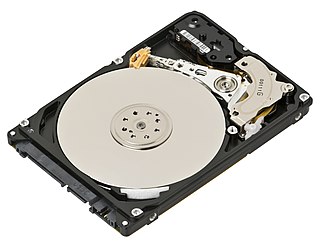
A hard disk drive (HDD), hard disk, hard drive, or fixed disk is an electro-mechanical data storage device that stores and retrieves digital data using magnetic storage with one or more rigid rapidly rotating platters coated with magnetic material. The platters are paired with magnetic heads, usually arranged on a moving actuator arm, which read and write data to the platter surfaces. Data is accessed in a random-access manner, meaning that individual blocks of data can be stored and retrieved in any order. HDDs are a type of non-volatile storage, retaining stored data when powered off. Modern HDDs are typically in the form of a small rectangular box.

A tape drive is a data storage device that reads and writes data on a magnetic tape. Magnetic-tape data storage is typically used for offline, archival data storage. Tape media generally has a favorable unit cost and a long archival stability.
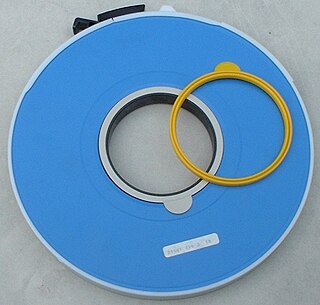
Write protection is any physical mechanism that prevents writing, modifying, or erasing data on a device. Most commercial software, audio and video on writeable media is write-protected when distributed.
In computing, a removable media is a data storage media that is designed to be readily inserted and removed from a system. Most early removable media, such as floppy disks and optical discs, require a dedicated read/write device to be installed in the computer, while others, such as USB flash drives, are plug-and-play with all the hardware required to read them built into the device, so only need a driver software to be installed in order to communicate with the device. Some removable media readers/drives are integrated into the computer case, while others are standalone devices that need to be additionally installed or connected.

REV is a removable hard disk storage system from Iomega.

The Jaz drive is a removable hard disk storage system sold by the Iomega company from 1995 to 2002.

A head crash is a hard-disk failure that occurs when a read–write head of a hard disk drive makes contact with its rotating platter, slashing its surface and permanently damaging its magnetic media. It is most often caused by a sudden severe motion of the disk, for example the jolt caused by dropping a laptop to the ground while it is operating or physically shocking a computer.
IBM manufactured magnetic disk storage devices from 1956 to 2003, when it sold its hard disk drive business to Hitachi. Both the hard disk drive (HDD) and floppy disk drive (FDD) were invented by IBM and as such IBM's employees were responsible for many of the innovations in these products and their technologies. The basic mechanical arrangement of hard disk drives has not changed since the IBM 1301. Disk drive performance and characteristics are measured by the same standards now as they were in the 1950s. Few products in history have enjoyed such spectacular declines in cost and physical size along with equally dramatic improvements in capacity and performance.

Cylinder-head-sector (CHS) is an early method for giving addresses to each physical block of data on a hard disk drive.
In computing, external storage refers to non-volatile (secondary) data storage outside a computer's own internal hardware, and thus can be readily disconnected and accessed elsewhere. Such storage devices may refer to removable media, compact flash drives, portable storage devices, or network-attached storage. Web-based cloud storage is the latest technology for external storage.
Disk cartridge or Optical disk cartridge may refer to:
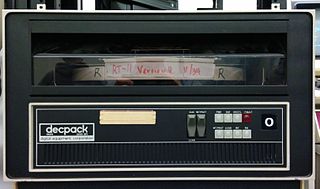
Digital Equipment Corporation's RK05 is a disk drive whose removable disk pack can hold about 2.5 megabytes of data. Introduced 1972, it is similar to IBM's 1964-introduced 2310, and uses a disk pack similar to IBM's 2315 disk pack, although the latter only held 1 megabyte. An RK04 drive, which has half the capacity of an RK05, was also offered.
Storage Module Drive (SMD) is a family of storage devices that were first shipped by Control Data Corporation in December 1973 as the CDC 9760 40 MB (unformatted) storage module disk drive. The CDC 9762 80 MB variant was announced in June 1974 and the CDC 9764 150 MB and the CDC 9766 300 MB variants were announced in 1975. A non-removable media variant family of 12, 24 and 48 MB capacity, the MMD, was then announced in 1976. This family's interface, SMD, derived from the earlier Digital RP0x interface, was documented as ANSI Standard X3.91M - 1982, Storage Module Interfaces with Extensions for Enhanced Storage Module Interfaces.

In 1953, IBM recognized the immediate application for what it termed a "Random Access File" having high capacity and rapid random access at a relatively low cost. After considering technologies such as wire matrices, rod arrays, drums, drum arrays, etc., the engineers at IBM's San Jose California laboratory invented the hard disk drive. The disk drive created a new level in the computer data hierarchy, then termed Random Access Storage but today known as secondary storage, less expensive and slower than main memory but faster and more expensive than tape drives.

A floppy disk is a disk storage medium composed of a thin and flexible magnetic storage medium encased in a rectangular plastic carrier. It is read and written using a floppy disk drive (FDD). Floppy disks were an almost universal data format from the 1970s into the 1990s, used for primary data storage as well as for backup and data transfers between computers.
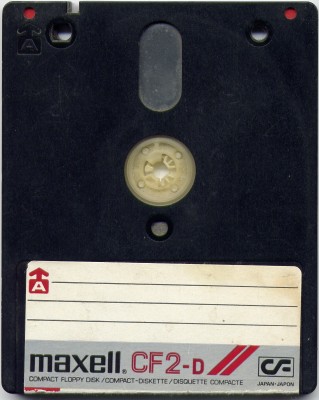
The floppy disk is a data storage and transfer medium that was ubiquitous from the mid-1970s well into the 2000s. Besides the 3½-inch and 5¼-inch formats used in IBM PC compatible systems, or the 8-inch format that preceded them, many proprietary floppy disk formats were developed, either using a different disk design or special layout and encoding methods for the data held on the disk.
John Mason "Jack" Harker was an inventor, mechanical engineer, and product and program manager who pioneered development of disk storage systems. Starting as a member of the original team that developed the first disk storage system, he went on to develop IBM Direct Access Storage products for the next 35 years. Over that time, Harker was twice director of the IBM San Jose Storage Laboratories, an IBM Fellow, and an IEEE Fellow. He retired from IBM in 1987 and died in 2013.